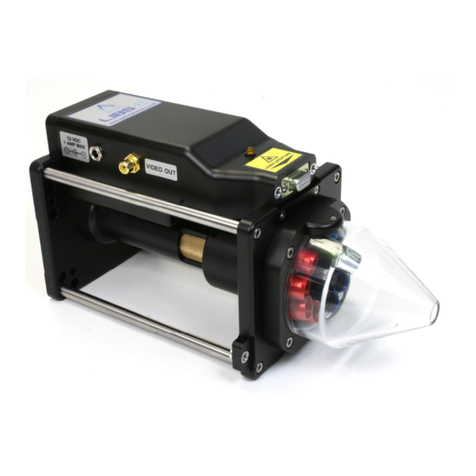
© 1998 - 2018 Applied Photonics Ltd Page 3 of 23
1 Introduction
LIBSCAN 25+ is a fully portable Laser-Induced Breakdown Spectroscopy (LIBS) instrument adopting
the same modular design principles used in our LIBSCAN range of products. Suitable for laboratory or
field applications, LIBSCAN 25+ operates from its internal 12 Volt 8Ah Li-Ion battery and can operate
for up to 4 hrs from a single charge. Recharging is achieved using a mains plug-in adaptor Li-Ion charger
which is supplied with the instrument. The six-channel design of LIBSCAN 25+ allows for up to six
compact spectrometers to be installed (approx. 185 –900 nm), depending upon the requirements of the
intended application and budget limitations. LIBSCAN 25+ can be supplied with an optional integrated
imaging camera for recording close-up video / still images of the sample. LIBSCAN 25+ is, by design, a
Class 4 laser product although when used with one of our range of modular sample chambers the product
meets Class 1 laser safety standards.
This User’s Manual provides the necessary information needed to configure the LIBSCAN 25+
instrument and how to use it safely. It is assumed that the user will be familiar with the safety issues
arising from the use of high-power lasers and will have preferably been trained in the safe use of high-
power laser products.
2 Safety
2.1 Laser radiation
LIBSCAN 25+ contains a high-power Q-switched Nd:YAG laser (Class 4, nominally 50 mJ @ 1064 nm,
5 ns pulse length, 1 Hz pulse repetition rate) and so it is imperative that it is operated only by suitably
trained and experienced persons who are fully aware of the hazards inherent to this type of high-power
laser equipment. It is imperative also that, prior to using the equipment, an appropriate risk assessment is
conducted in such a way as to take account of the proposed use of the equipment, the environment in
which the equipment is to be operated, and how its use may affect people who are not directly involved
with the use of the equipment.
Laser product classification label
LIBSCAN 25+ is designed to meet the laser safety requirements of the relevant European standards (BS
EN 60825-1: 2014) and USA standards (ANSI Z136.1 –2014). Although LIBSCAN 25+ may be
supplied with a sample chamber which provides adequate containment of the laser radiation to Class 1
Accessible Emission Limits, it is possible for the user to operate LIBSCAN 25+ without the sample
chamber (ie. operation in “open beam” mode as may be required for certain types of experiment).
Accordingly, it is necessary to consider LIBSCAN 25+ to be a Class 4 Laser Product and so, by
definition, the equipment poses a risk of personal injury (eye, skin injury) and poses a fire risk. As with
all Class 4 laser products, appropriate safety precautions must be taken as identified via a suitable risk




























